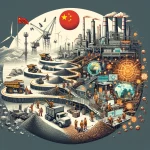
The Great Consolidation – How China became the worlds rare earths super power in 20 years.
March 7, 2024
Weekly News Review Mar 11 – Mar 17 2024
March 17, 2024Welcome to our weekly news review.
CHINA COMMITS MORE FUNDING TO RESOURCE EXPLORATION –
China invested around $15 billion in the search for natural resources last year.
According to China Daily, this was eight per cent more than the previous year. The newspaper quotes the Chinese Ministry of Natural Resources, saying that oil and gas exploration accounted for the largest share, making up more than 80 per cent of the budget. However, deposits of iron ore and rare earths were also discovered during the exploration work.
Despite its own market power in many raw materials, China is “highly dependent on some imported mineral resources,” said the responsible minister Wang Guanghua in January last year. Precautions must, therefore, be taken. The Global Times sees international efforts to secure the supply of critical resources as a threat to competition. China’s efforts to increase its exploration and production capacities are correspondingly urgent. This is also being achieved through the integration of artificial intelligence.
MALAYSIA SEEKS TO STREAMLINE RARE EARTHS SECTOR –
Members of Parliament urge the administration to set up a government-linked company to ramp up exploration efforts for critical minerals.
Malaysian Member of the Parliament (MP) Datuk Larry Sng urged the administration to create a government-linked company (GLC) to oversee the country’s rare earth industry, seeking to expand the sector while recognizing the environmental burden, according to the Malay Mail.
Sng added that a GLC supervising the industry would streamline the sector’s expansion while regulating environmental protection efforts. The MP said the GLC could be comparable to Petronas, the Malaysian state-owned company overseeing the country’s oil and gas industry.
LARGE DEPOSITS – LITTLE MINING –
A Malaysian minister told the Parliament last year that there were about 16.1 million tons of non-radioactive rare earth elements in the country.
Despite having these reserves, Southeast Asian countries only mine a few deposits. Malaysia’s leading part in the rare earth industry is in the processing step in the largest refinery outside China in the East of the Malaysian Peninsula, operated by Australian company Lynas. The plant processes rare-earth concentrates produced at Lynas’ Mount Weld’s rare-earth operation in Western Australia.
Despite recent back-and-forth developments surrounding the plant, Lynas is committed to partnering with Malaysia’s rare earth industry. According to a press statement, the company’s CEO Amanda Lacaze met with Anwar Ibrahim, Prime Minister of Malaysia, at the ASEAN Summit in Melbourne on Tuesday. Still, the details of the talks were not disclosed.
AUSTRALIA – VIETNAM RELATIONS ENTER NEW ERA WITH RESPECT TO STRATEGIC METALS :
The two countries conclude a Comprehensive Strategic Partnership.
According to a joint statement, Australian Prime Minister Anthony Albanese and the Prime Minister of Vietnam, Pham Minh Chính, announced lifting the relations between the two countries to a Comprehensive Strategic Partnership. Albanese called the upgrade a “new era for Australia-Vietnam relations,” adding that the two countries share similar goals in sustainability, trade, defence, and other fields.
As part of the Comprehensive Strategic Partnership, Vietnam and Australia will hold an annual ministerial dialogue on energy and minerals to increase cooperation in the sectors, including raw material supply chains.
The two countries have extensive critical mineral resources for advanced technologies and renewable energies. Australia is a significant lithium and copper producer and a major rare earth player. Conversely, Vietnam has set the target of reaching two million tons of rare earth production annually by 2030.
To achieve this ambitious goal, the country seeks foreign investment and expertise. Two Australian rare earth companies have already signed agreements with Vietnamese partners, and the new elevated partnership could further boost collaboration between the two countries.
2 GIANTS – 20 YEARS – THE CONSOLIDATION OF CHINA TO A RARE EARTH SUPERPOWER:
Rare earths and China are often mentioned in the same breath. The Middle Kingdom possesses the world’s largest known deposits of these critical minerals and has a virtual monopoly on their mining and processing. The Bayan Obo mine in Baotou, Inner Mongolia Autonomous Region, is known as the “world capital of rare earths” — a status resulting from decades of planning and targeted political decisions.
The country’s nuclear program is the key to China’s current dominance in rare earths. In the 1950s, critical technological foundations were laid for the process, which developed around 20 years later to separate raw rare earth materials. The new method marked a change in the global division of labour. Until then, China had exported its raw materials to other countries for further processing. After introducing the new methods, the old relationship gradually began to reverse. In the mid-1980s, China replaced the U.S. as the world’s largest producer of rare earths. Exports increased, while prices for rare earths dropped due to overcapacity. Between 2002 and 2005, many other suppliers found themselves unable to compete with China’s rare earth supply and pricing, which led to the closure of several mines (PDF), including the formerly important Mountain Pass mine in the U.S.
However, this increasingly dynamic production growth created a fragmented industry in China with thousands of mines, some of which were illegal, competing fiercely with each other and often circumventing environmental and safety regulations. This situation depressed prices, so the government decided on a far-reaching plan to clean up the market and give it more clout.
REORGANISATION –
The State Council of the People’s Republic considered consolidating the solution and approved the corresponding plans in 2002. At the same time, it initiated a reduction in the number of market participants for 14 other resources — antimony, bauxite, lead, iron ore, gold, potassium, coal, copper, manganese, molybdenum, phosphorus, tungsten, zinc, and tin — in addition to the rare earth group.
In the rare earth sector, the reasons for the project were complex. Above all, the Chinese government wanted more control over pricing. Due to the fragmented market, Beijing’s influence in this area was limited despite the country’s international quasi-monopoly of the extraction and processing of critical raw materials. Individual companies sometimes undercut each other. The Chinese Minister of Industry and Information Technology, Xiao Yaqing, was still complaining in 2021 that China was selling rare earths at the price of earths rather than the price of something scarce. Beijing also hoped consolidation would simplify decision-making and enforcement processes in the sector. Growing environmental concerns and a plethora of illegally operating mining companies connected to smuggling activities were cited as additional concerns that consolidation would address. Another factor supporting market concentration was the goal of upgrading quality in the industry. Consolidation would give the government more influence over the industry’s ongoing development and modernization.
A FRAGMENTED MARKET – LOCAL RESISTANCE – NORTH AND SOUTH DIVIDE :
The project, which has been running since 2002, envisaged only two large companies for rare earths in the long term: one in the north and one in the south. This choice was due to natural geographical conditions and the different mining histories in the individual regions. In the north, ores are extracted from open-pit mines that predominantly contain light rare earths. In the south, heavy rare earths are extracted from ion adsorption clays. These clays are formed wherever strong weather conditions prevail. They are currently economically significant only in southern China and neighbouring Myanmar.
The plan also envisioned a consolidation of the downstream processing industry. In the north, processing companies have settled in Baotou, approximately 150 kilometres from the world’s most significant rare earth deposit, Bayan Obo.
The South was also characterized by a large number of players fighting for market dominance. Due to the large number of companies, the consolidation plans were (unsurprisingly) met with resistance. Pushback also came from provincial governments. They received taxes from locally operating companies, whereas those from centrally managed companies would flow to Beijing. Consolidation progressed far more smoothly in the north, mainly because its mining industry had been far more homogeneous for decades and in the hands of individual large companies.
CONSOLIDATION MAKES PROGRESS :
On the surface, consolidation progressed slowly as the government gradually granted fewer mining rights. By 2012, the number of licenses issued had fallen from 113 to 67, with 90% of these rights ending up with companies that later became part of China’s six largest rare earth companies, the so-called Big Six. Exports were also concentrated during this time, with the government authorizing only 22 companies to export rare earths in 2011. In 2006, there were 47.
In parallel to the measures in the domestic market, China also sought more control over exports. In 2006, the People’s Republic successfully introduced quotas limiting rare earth export quantities. China gradually tightened these quotas. In 2010, the Chinese customs authority even temporarily halted the export of rare earth to Japan due to a smouldering trade dispute, even though this was never officially confirmed. Fears of a nationwide supply freeze caused rare earth prices on the international market to rise to a level that has yet to be exceeded.
In 2012, the USA, the European Union and Japan filed a complaint with the World Trade Organization (WTO) against further tightening export quotas. The reason was that China violated applicable law by denying access to critical raw materials. In 2014, the WTO ruled against the People’s Republic, which was forced to drop the export quotas.
BIG SIX EMERGE:
In 2012, the rare earth industry in the autonomous region of Inner Mongolia came under the complete control of a subsidiary of the iron and steel group Baotou Iron and Steel, which has been operating under the name China Northern Rare Earth Group since 2014. After the consolidation of 35 producers, the rare earth industry in China’s north was controlled by one company.
Consolidation also made gradual progress in the south, but it wasn’t until 2016 that the first sustainable centralization was completed. By consolidating hundreds of companies into five — Xiamen Tungsten, Minmetals Rare Earth, Guangdong Rare Earth, the rare earth division of Chinalco (Aluminium Corporation of China), and China Southern Rare Earth — the industry in the south was now also streamlined in organizational terms. By 2016, together with the China Northern Rare Earth Group in the north, China’s entire rare earth sector was in the hands of six large companies, the so-called Big Six.
The next step in creating two market-dominating groups took place in 2021. Three of the Big Six—the rare earth division Chinalcos, Minmetals Rare Earth, and China Southern Rare Earth—merged under the name China Rare Earth Group (CREG). The three companies each held a 20 per cent stake in CREG. In addition, the Chinese government held a direct 30% stake in CREG in the form of the State-owned Assets Supervision and Administration Commission. The remaining ten per cent was distributed among smaller research companies.
The takeover of Guangdong Rare Earth in 2024 was the last official step in streamlining China’s rare earth industry for the time being. This left Xiamen Tungsten as the only independent company. However, Xiamen Tungsten and CREG had been cooperating since 2023 in a joint venture in which CREG held more than 50 per cent—the scheme aimed to pool production quotas. Therefore, the days of Xiamen Tungsten’s independence were, therefore, already numbered.
2 GIANTS EMERGE:
Beijing published new production quotas in February 2024. Only two companies are listed: the China Northern Rare Earth Group in the north, which is solely responsible for light rare earths, and the China Rare Earth Group in the south, which is also permitted to mine heavy rare earths. Since Xiamen Tungsten is no longer listed, but since its quotas are combined with CREG, it can be deduced that the consolidation plans have now been implemented.
This marks the end of a project that began over two decades ago.






